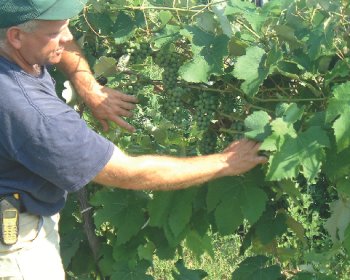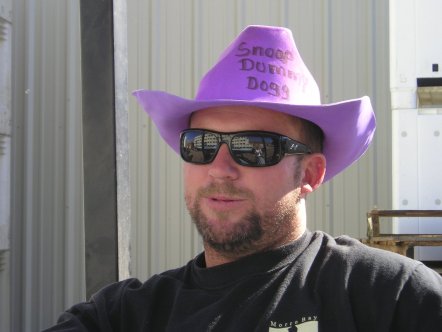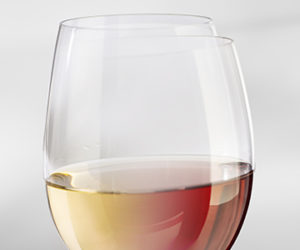You know from art class that red and white make pink, but is the same true for wine? Often rosès and blush wines are made from red grapes that are briefly exposed to the skins and then vinified as a white wine. Some pink wines, however (especially some of the world’s most revered sparkling wines), are a different breed. This issue, three professional winemakers offer their advice for making rosès from blends of red and white wines.

Jim Quarella, owner and winemaker of Bellview Winery in Landisville, New Jersey, is a successful fourth-generation farmer who transformed his great-grandfather’s farm into a vineyard and award-winning winery. Bellview’s blush wine, Under the Arbor, is a blend of Cayuga, Ives and Fredonia.
When we make a blend like Under the Arbor, the wines are kept separate until the time of blending. This gives us the opportunity to do trial blends in order to produce what we feel is the best possible wine.
However, in other instances we blend grapes before the crush. For example, we blend a small amount of Viognier in our Syrah at crush when we can to help color stability and bring out more fruit. By keeping the wines separate, though, it is easier to avoid some of the challenges such as color consistency and maintaining proper acid levels.
If you’re interested in making a rosè with this method, I would say come up with an idea of what you want your blend to be beforehand – for example, 80% Chardonnay and 20% Grenache. The grape blend would, of course, depend on the style you want to achieve. Then you can experiment, evaluate and make adjustments.
No aging is necessary in these blends because they are light and fruit-forward types of wines, and they don’t have the certain structure a wine needs to be able to age. When you age a wine, you lose fruit but develop other complexities
Winemakers can have fun with these blends and it’s easier to make a more consistent, higher quality wine if you blend finish wines. You can also make wines you like rather than wines to please a customer.

Winemaker Jeff Murphy of Johnson Estate Winery in Westfield, New York is in charge of production of their estate-bottled namesake wines, as well as their alternate label, Freelings Creek. He joined the Chautauqua County winery and vineyards five years ago.
It is very practical for home winemakers to attempt white and red blends. You can make a unique wine from any base wines you already have and it is a logical extension of winemaking. Making a blend like this is also fun and practical and you don’t have to buy anything special.
Choose wines that blend well. For example, natives blend well with other natives as do hybrids like Cayuga with GR7 or Baco, or Delaware blended with Foch or Ives. Also look for Pinot Noir. It’s hard to get Pinot ripe, but it is usually ripe enough for a good rosè. Like all grapes for winemaking, you want ripe, clean fruit to start. If you purchase juice, try to get it with low sulfurous levels.
Bench trials are the most important lab procedure you can do and they help prevent expensive mistakes. We keep our wines separate until a few weeks before blending, mostly because of tank restraints. See what works with what you have on hand. Don’t forget sugar in the trial if you plan to sweeten.
The balance of acid, sweetness and alcohol is critical in a rosè, especially if you’re blending. If you’re using, say, California grapes or juice at 25–28 °Brix, it isn’t going to make a pleasant rosè without significant blending. I like acid in rosè or blush wines because it makes the wine very food friendly and refreshing. I recently had a $15 rosè that had very nice color and aromatics but turned out to be flabby and alcoholic. I think that if the grapes had been harvested a bit earlier the wine would have been great.
Tex Sawyer holds an M.S. in food science from UC-Davis with a specialization in enology. He joined Scharffenberger Cellars in 1989 as winemaker, and oversees their premium sparkling wines.
Rosès should be clean, light, and fruity with a pleasing acidity (0.65-0.7g/100mL TA as tartaric or more, if you like). They are food, sipping and party wines. They should be drunk cool (45-55 °F/7-13 °C) and kept away from the ice bucket. If served too cold you lose a lot of the aroma. If you have a problem wine, however, then the colder the better. Basically they are crisp, white wines with color, extra red fruit aromas and body which will age similarly. I recommend drinking them within a year of production so that they are still fresh and fruity. You can age if you want but you will lose the aromatics of the fresh product and they tend to turn orange with oxidation.
Many still rosès are made by picking red grapes at 12–13% potential alcohol, short-term skin contact and pressing off before too much color and astringent and bitter polyphenols (tannins) are extracted. You want fruit flavors and a little of the color that you get from the skin and the pulp next to it. Making rosès by mixing red wine into a white wine base blend, as is done in Champagne for sparkling rosès, allows a greater amount of control on the color, consistency and polyphenolic balance of the finished product that you do not get by the early pressing method. It is the method that I would recommend to home winemakers for the best results.
When making our blends, we keep all varieties, vineyards, blocks, appellations and production protocol batches separate until after fermentations, finings and first filterings are completed. At that time we taste everything and select which wines most closely fit the styles and types of wine that we are making. We then blend in the cellars, cold stabilize (remove potassium bitartrate crystals) and polish filter.
Sparkling rosès are made similarly. Even though most sparkling winemakers use some combination of Chardonnay and Pinot Noir to make the base blends of their wines, these wines are white because the juice of the Pinot Noir is white. We use a blend of the two grapes because it gives us the best balance of fruit and perfume as well as body and structure in the mouth.
We make special red wines for our sparkling rosè blend. We pick at about 23–24° Brix (ca 13% potential alcohol) and ferment on the skins, punching down twice a day until about 5° Brix when we drain off and allow the fermentation to finish in a tank or neutral barrel. This wine has fewer bitter tannins from the seeds. We also use only the free run juice.
Blends when properly done allow you to add extra nuances, balance, complexity and make up deficits in the individual wines. Besides it is great fun to try different combinations and see what happens.







